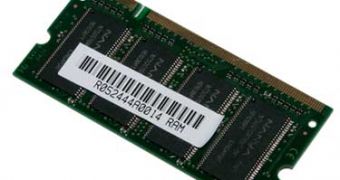Random access memory, RAM for short, is one of the most important computer hardware parts as a high enough amount of it can drastically change the way a computer system performs its tasks. Essentially, the RAM is the place where information awaiting processing is stored. As computers become faster thanks to better processors, they also become more responsive thanks to the random access memory. For a middle level computer, nowadays it is normal to have between 512MB and 1.5GB of system memory. As the trend in computer industry is to equip machines with more and more RAM, alternatives for the traditional design are explored.
IBM and the Japanese company TDK entered a partnership in order to develop another technology for random access memory, a technology called spin torque transfer RAM, or STT-RAM. The STT-RAM works on a different principle than the traditional RAM design, as an electric current is applied to a magnet and so it changes the direction of the magnetic field. As the magnetic field changes its direction, it causes a change in a resistance and those changes are then interpreted as 1s and 0s. The IBM and TDK joint venture will develop a working STT-RAM prototype within the next four years using the 65 nanometer fabrication process.
The STT-RAM is not the only RAM design explored by IBM; the company experimented with a type of magnetic memory different from the STT-RAM that was called MRAM. The more conventional design of the MRAM had the density disadvantage, as IBM encountered some problems in shrinking the transistors on these chips. "As you make that device smaller (MRAM), you need to increase the magnetic field, and to continue to write (data), it becomes impractical," said Bill Gallagher, senior manager of exploratory nonvolatile memory at IBM, who was cited by the news site News.com. "To scale beyond 65-nanometer, we have to find a new mechanism to write information." The company never released MRAM chips commercially and all built prototypes were made using older fabrication processes like the 90 nanometer one. The only MRAM chips available on the market today are the ones built and sold by Freescale Semiconductor, but the manufacturer said that there are strong doubts on whether the technology is viable or not.
As the MRAM looks like a dead end, STT-RAM and phase-change memory are probably the two technologies that will meet on the market of the future as each design has its own advantages. The STT-RAM is faster but the phase change memory is much denser, offering better storage options. As the phase change memory is based on changing the structure of a material from crystalline to amorphous, by heating it to high temperatures, STT-RAM may have the advantage of lasting longer and being safer to implement and use. Even if the "big blue company" makes most of its impressive revenues from servers, mainframes and related fields and services, IBM is also interested in making chips and developing intellectual property. Developing a new design of memory will give it an edge on the chips market.

 14 DAY TRIAL //
14 DAY TRIAL //